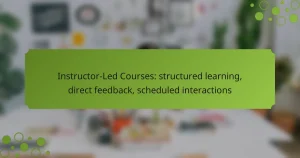
Hybrid learning models integrate online and in-person education, providing a flexible approach that accommodates diverse learning styles and schedules. This innovative method enhances student engagement and allows for personalized educational experiences, making learning more accessible and effective.

What are the benefits of hybrid learning models?
Hybrid learning models combine online and in-person education, offering several advantages such as increased flexibility, diverse learning environments, and enhanced engagement. These models cater to various learning styles and can lead to more personalized educational experiences.
Flexibility in scheduling
One of the primary benefits of hybrid learning is the flexibility it provides in scheduling. Students can choose when to attend classes in person and when to engage with online materials, allowing them to balance education with personal commitments. This flexibility is particularly beneficial for working adults or those with family responsibilities.
For example, a student might attend in-person lectures on weekends while completing online assignments during the week. This adaptability can lead to improved time management and reduced stress.
Diverse learning environments
Hybrid learning models create diverse learning environments that cater to different educational needs. Students can benefit from both the social interaction of face-to-face classes and the self-paced nature of online learning. This combination allows for a richer educational experience.
For instance, a student might participate in group discussions during in-person sessions while using online platforms for research and collaboration. This blend can enhance understanding and retention of material.
Enhanced student engagement
Hybrid learning can significantly enhance student engagement by incorporating various teaching methods. Interactive online tools, such as discussion boards and multimedia resources, can complement traditional classroom activities, keeping students actively involved in their learning process.
Moreover, the ability to switch between formats can cater to different learning preferences, making lessons more appealing and effective. Engaged students are more likely to participate and retain information.
Personalized learning experiences
Hybrid learning models allow for personalized learning experiences tailored to individual student needs. With access to online resources, students can progress at their own pace, revisiting challenging topics or advancing through material they find easier.
Educators can also use data from online platforms to identify areas where students may need additional support, enabling targeted interventions. This personalized approach can lead to better academic outcomes and increased satisfaction.
Cost-effectiveness
Hybrid learning can be more cost-effective for both institutions and students. Schools can reduce overhead costs by minimizing the need for physical space and resources, while students may save on transportation and accommodation expenses.
Additionally, many online courses are offered at lower tuition rates compared to traditional in-person classes. This financial flexibility can make education more accessible, particularly for those on a budget.

How do hybrid learning models work?
Hybrid learning models combine online and in-person education to create flexible learning environments. This approach allows students to benefit from the advantages of both formats, accommodating various learning styles and schedules.
Combination of online and in-person classes
Hybrid learning integrates traditional face-to-face classes with online coursework, providing a balanced educational experience. Students might attend lectures in person while completing assignments or participating in discussions online. This flexibility can help accommodate diverse schedules and learning preferences.
For instance, a student might attend a weekly seminar on campus but engage in online discussions and submit assignments through a learning management system. This model can enhance accessibility, particularly for those with commuting challenges or other commitments.
Use of technology for collaboration
Technology plays a crucial role in hybrid learning by facilitating collaboration among students and instructors. Tools such as video conferencing, discussion forums, and collaborative documents enable real-time interaction and resource sharing, regardless of location.
Platforms like Zoom or Microsoft Teams allow for seamless communication during live sessions, while tools like Google Docs support collaborative projects. Ensuring that all participants are comfortable with these technologies is essential for maximizing engagement and effectiveness.
Structured learning paths
Effective hybrid learning models provide structured learning paths that guide students through their educational journey. Clear objectives, timelines, and resources help students stay organized and focused, whether they are learning online or in person.
Institutions often design these paths to include a mix of synchronous (live) and asynchronous (on-demand) activities, allowing for a personalized pace. Regular check-ins and assessments can help ensure that students remain on track and receive the support they need to succeed.

What are the best practices for implementing hybrid learning?
Effective implementation of hybrid learning requires a structured approach that combines online and in-person elements. Key practices include establishing clear communication, providing regular feedback, and ensuring instructors receive adequate training.
Clear communication strategies
Clear communication is essential in hybrid learning to keep students informed and engaged. Utilize multiple channels such as emails, learning management systems, and messaging apps to convey important information and updates.
Consider setting up a weekly schedule that outlines both online and in-person activities. This helps students manage their time effectively and reduces confusion about expectations.
Regular feedback mechanisms
Implementing regular feedback mechanisms allows educators to gauge student understanding and adapt their teaching methods accordingly. Use surveys, quizzes, and discussion forums to collect insights on student progress and areas needing improvement.
Encourage students to provide feedback on both the online and in-person components of the course. This two-way communication fosters a collaborative learning environment and can lead to enhancements in the hybrid model.
Training for instructors
Training for instructors is crucial to ensure they are comfortable and effective in a hybrid learning environment. Provide professional development opportunities focused on technology tools, instructional design, and student engagement strategies.
Consider pairing experienced instructors with those new to hybrid teaching for mentorship. This can help build confidence and share best practices, ultimately leading to a more effective learning experience for students.

What tools support hybrid learning?
Hybrid learning relies on various tools that facilitate the integration of online and in-person education. Key tools include Learning Management Systems (LMS), video conferencing platforms, and collaboration tools, each playing a crucial role in creating a flexible learning environment.
Learning Management Systems (LMS)
Learning Management Systems are essential for organizing and delivering educational content in hybrid learning. They allow educators to upload materials, track student progress, and manage assessments all in one place.
When selecting an LMS, consider factors like user-friendliness, integration capabilities with other tools, and support for various content types. Popular options include Moodle, Canvas, and Blackboard, which cater to different institutional needs.
Video conferencing platforms
Video conferencing platforms enable real-time interaction between students and instructors, making them vital for hybrid learning. Tools like Zoom, Microsoft Teams, and Google Meet facilitate live classes, discussions, and presentations.
For effective use, ensure that the chosen platform supports features like breakout rooms for group work, screen sharing for presentations, and recording capabilities for later review. Check for bandwidth requirements to ensure smooth operation during classes.
Collaboration tools
Collaboration tools enhance communication and teamwork among students and instructors in a hybrid setting. Applications such as Slack, Trello, and Google Workspace allow users to share documents, manage projects, and communicate seamlessly.
When implementing collaboration tools, prioritize those that integrate well with your LMS and video conferencing platforms. Encourage students to utilize these tools for group projects and peer feedback, fostering a sense of community even in a hybrid environment.

What are the challenges of hybrid learning models?
Hybrid learning models face several challenges, including technical issues and student engagement hurdles. These obstacles can hinder the effectiveness of blending online and in-person education, requiring careful management to ensure a successful learning experience.
Technical issues
Technical issues in hybrid learning often arise from unreliable internet connections, inadequate hardware, or software compatibility problems. Students may struggle with accessing online resources or participating in virtual classes due to these challenges.
To mitigate technical difficulties, institutions should provide clear guidelines on required technology and offer support resources. Regularly testing systems and ensuring that all participants have access to necessary tools can help reduce disruptions.
Student engagement hurdles
Maintaining student engagement in hybrid learning environments can be difficult, as some students may feel isolated or disconnected from their peers. The lack of face-to-face interaction can lead to decreased motivation and participation.
To enhance engagement, educators can implement interactive tools such as polls, breakout rooms, and collaborative projects. Encouraging regular communication and feedback can also foster a sense of community, helping students feel more involved in their learning process.


